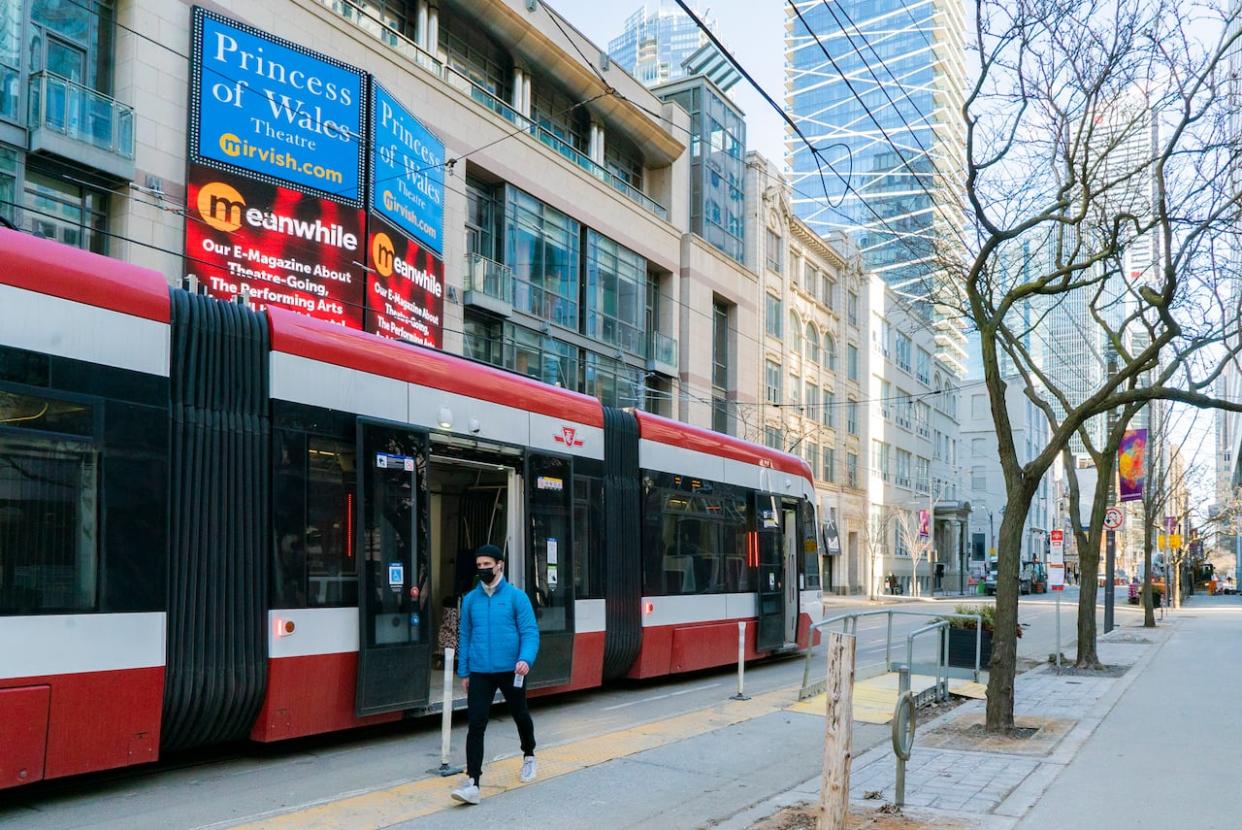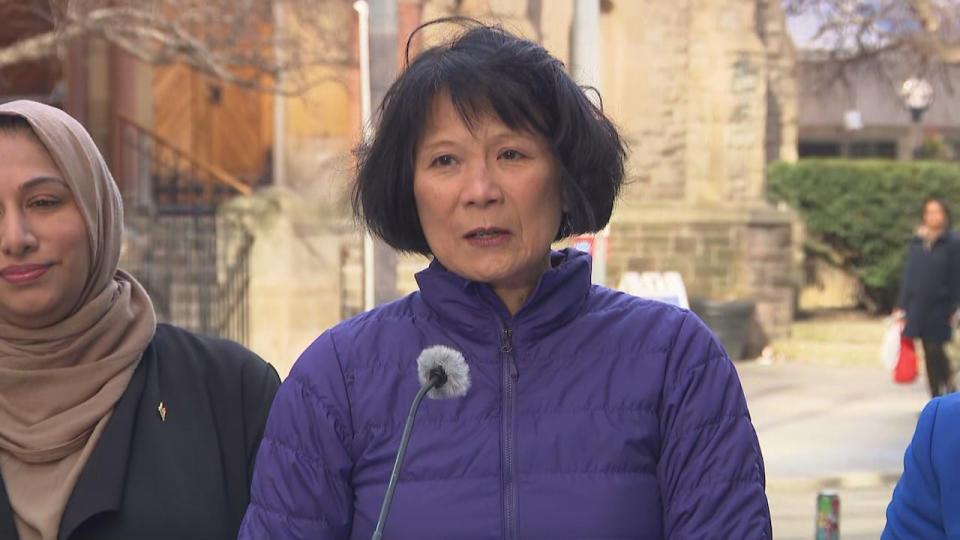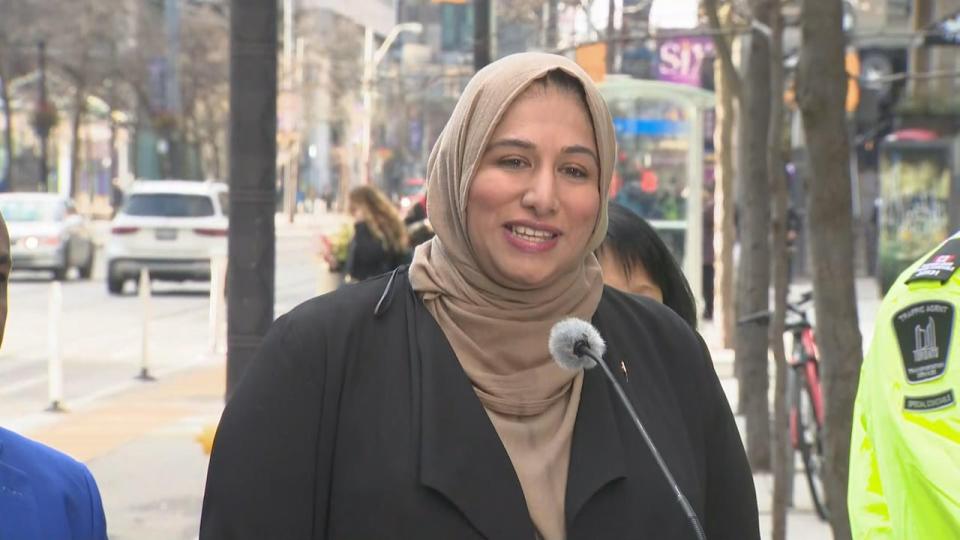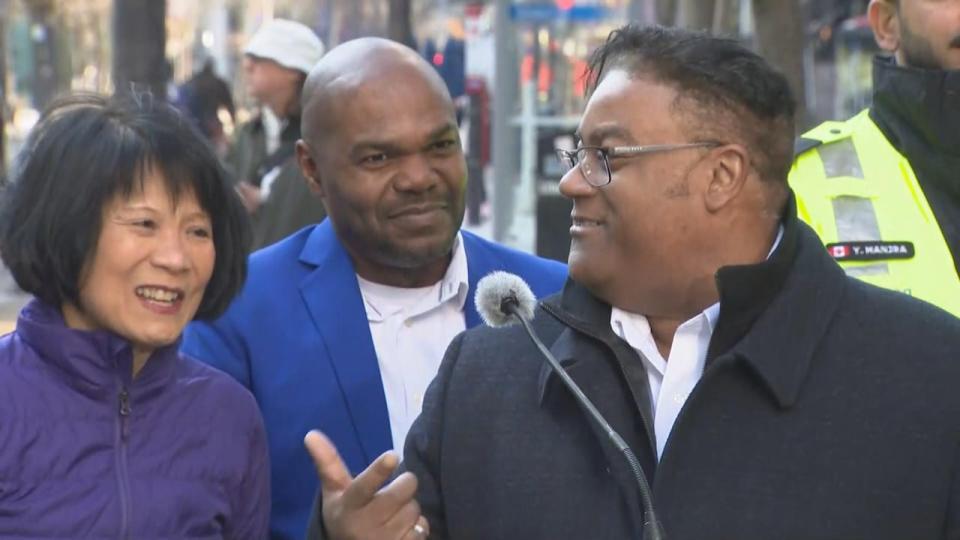Traffic flowing 3 times faster on King Street transit corridor since city agents deployed: mayor

Traffic flow along the King Street transit priority corridor is now three times faster following the deployment of traffic agents in December, Toronto Mayor Olivia Chow announced Friday.
At a news conference at the intersection of King Street and University Avenue, Chow said thousands of people spend hours every day on King Street going to work or school.
She said a lot of that time is spent "sitting in traffic, staring out the window, being stuck in traffic, and that is not a good experience."
In December, the city rolled out a number of traffic management strategies along the corridor to improve traffic flow and safety for all road users. Chow said those strategies are now bearing fruit.
"Traffic agents on King Street make the traffic three times faster. Three times. It used to be almost like an hour, 60 minutes… on this streetcar route. It's now 17 minutes, it's so much faster. It also feels better because you're moving — not being stuck behind cars," Chow said.
"Why is the traffic agent so effective? Because they get the traffic flowing, moving faster and smoother. They keep people safe and it keeps the drivers and everybody else obeying the law."

At a news conference at the intersection of King Street and University Avenue on Friday, Mayor Olivia Chow said thousands of people spend hours every day on King Street commuting to work or school. (Hugo Levesque/CBC)
Chow said six intersections along the corridor now have a combined total of 12 agents during peak traffic periods. The intersections are:
King Street and University Avenue.
King Street and York Street.
King Street and Bay Street.
King Street and Yonge Street.
King Street and Church Street.
King Street and Jarvis Street.
In November 2017, the city launched a pilot project that prioritized streetcar traffic on a 2.6-kilometre stretch of King Street W. to improve transit.
In April 2019, city council voted to make the King Street transit pilot permanent. Private vehicles, while not banned, were supposed to be restricted at a majority of intersections.
Last November, a University of Toronto study found that more than 99.7 per cent of drivers who violated traffic rules on a stretch of King Street West downtown were not getting tickets from the Toronto police. The researchers found that there were about 6,800 illegal turns and movements at intersections daily on the King Street transit priority corridor, with less than 0.3 per cent of drivers on average being ticketed.
The city says traffic agents are empowered to manage traffic at intersections by dynamically directing road users in real-time, enforcing transit priority and restricting motor traffic at most intersections along the corridor, with exceptions for local access.
"The data says that when there's a traffic agent present, they stop vehicles from blocking intersections 96 per cent of the time," Chow said. "They are also making sure the pedestrians and cyclists are also following the rules [and] it also prevents illegal parking."
Chow's transit priority
The mayor said "transit is a high priority" and she is "willing to spend extra dollars to make sure that the streetcars are moving and make sure that rules are being obeyed and people are not so frustrated being stuck in traffic."
Roger Browne, director of traffic management for the city of Toronto, said the traffic agents are at the intersections seven hours a day, but the city could soon be looking at expanding their hours.

Deputy Mayor Ausma Malik, the city councillor for Spadina-Fort York, also spoke at the news conference. (Hugo Levesque/CBC)
Deputy Mayor Ausma Malik, city councillor for Spadina-Fort York, has been a vocal supporter of the King Street pilot from the start.
As a transit rider, she said she shared the frustration of residents and local businesses over enforcement on the route.
"I've been working hard with my colleagues to ensure that improvements are being made to meet King Street's potential," Malik said.
"And for the transit corridor to work well, both effective enforcement and street design are required … Better enforcement has been our first and very significant step, and as the data shows, the addition of traffic agents along King has resulted in quicker travel times for transit users and safer travelling for pedestrians and cyclists."
Last November, Coun. Chris Moise moved a motion to council requesting a report on the feasibility of installing automated enforcement along the King Street priority corridor.
He said he's looking forward to receiving the report in the second quarter of this year and moving ahead to more consistent enforcement on King Street.
"We know Torontonians want their transit journeys to be fast, reliable and safe," Moise said.
"The city's actions to improve traffic flows through the King Street transit priority corridor ensure a better experience for all road users."

Mayor Chow, left, Coun. Chris Moise, centre, and Roger Brown, director of traffic management for the City of Toronto, are pictured at Friday's news conference. (Hugo Levesque/CBC)
The city has implemented a number of other traffic management enhancements along the King Street transit corridor, including:
Modifying traffic signal timings to give streetcars more time to travel through intersections.
Adding dedicated transit signals to reduce the likelihood of motorists accidentally making an illegal move, such as running a red light during a green transit signal, as well as improving signage and road markings.
By mid-2024, temporary TTC platforms will be installed at 20 locations along King Street. These platforms are designed to increase safety and help transit riders enter and exit streetcars more easily.


